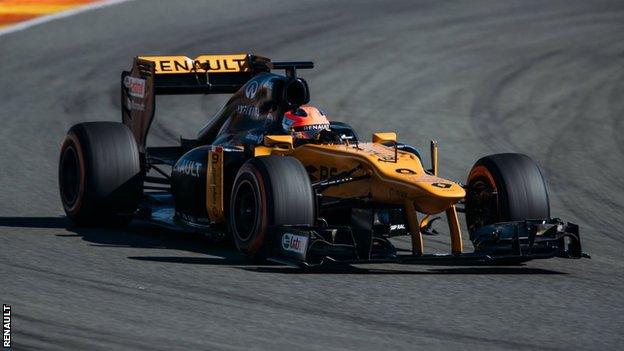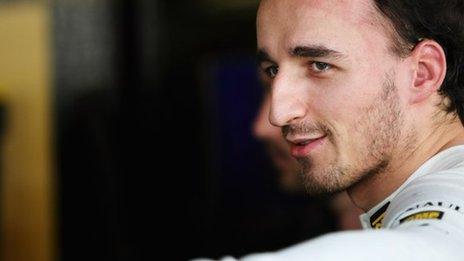Robert Kubica: Pole drives F1 car for first time since 2011 accident
- Published

Robert Kubica in action during the test session at Valencia on Tuesday
Robert Kubica has driven a Formula 1 car for the first time since the horrific rally accident that curtailed his career before the 2011 season.
The Pole, who won the 2008 Canadian Grand Prix for BMW Sauber, suffered a partially severed right arm, external that has left him with limited movement.
But on Tuesday he completed a full day's testing with Renault at the Ricardo Tormo track in Valencia, Spain.
It is not clear whether the test, in a 2012 car, means a comeback is possible.
Renault said Kubica "complained about grip, understeer, downforce and had the biggest smile on after his 115 laps".
A reporter from the French newspaper L'Equipe said on Twitter that the 32-year-old conducted a race-simulation run and set a fastest lap time quicker than Renault reserve driver Sergei Sirotkin. Renault were not available to verify the information.
Renault driver Jolyon Palmer is under pressure after a difficult first six races of the season, in which he has been out-performed by new team-mate Nico Hulkenberg.
The team are considering whether to replace the Englishman later in the season, with former F1 driver Sebastien Buemi and Sirotkin among the possible candidates.
Could private test lead to unlikely comeback?
Kubica's car shows severity of crash
Kubica's test, which Renault described as "private" and refused immediately to share any details, raises the intriguing possibility that he could also be in the frame.
A comeback would be a remarkable turn of events given the severity of his injuries.
Kubica, once considered one of the fastest and most talented drivers in F1, had not driven a grand prix car since pre-season testing in 2011.
A month before he was due to start his second year with Renault, Kubica's Skoda crashed at rally in Italy.
A metal barrier pierced the car and entered the cockpit, leaving him with major blood loss and multiple arm and leg fractures. His right arm was so severely injured there were fears it would have to be amputated.
A series of operations restored some movement in his arm but it has continued to have restricted mobility, which meant he could not fully turn a steering wheel in the tight confines of an F1 cockpit.
In February, he said he felt he could drive at "80% of the F1 tracks - but not all of them".
Being able to test successfully at Valencia does not necessarily mean Kubica would have the freedom of movement to drive competitively at tracks that require large degrees of steering lock, such as Monaco.
Four years ago, Kubica did some work in the simulator at the Mercedes in F1, and from 2013-16 he competed in rallying.
In recent months, Kubica has begun to explore a return to circuit racing, testing a variety of cars.
- Published7 June 2013
